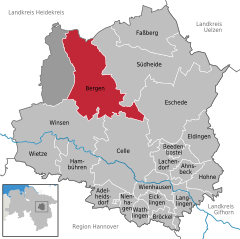This article needs additional citations for verification. (September 2015) |
Bergen | |
|---|---|
 St. Lambert's Church | |
Location of Bergen within Celle district  | |
| Coordinates: 52°48′37″N 9°57′40″E / 52.81028°N 9.96111°E | |
| Country | Germany |
| State | Lower Saxony |
| District | Celle |
| Subdivisions | 13 districts |
| Government | |
| • Mayor (2019–24) | Claudia Dettmar-Müller[1] |
| Area | |
| • Total | 163.77 km2 (63.23 sq mi) |
| Elevation | 77 m (253 ft) |
| Population (2022-12-31)[2] | |
| • Total | 13,532 |
| • Density | 83/km2 (210/sq mi) |
| Time zone | UTC+01:00 (CET) |
| • Summer (DST) | UTC+02:00 (CEST) |
| Postal codes | 29303 |
| Dialling codes | 05051 |
| Vehicle registration | CE |
| Website | www.bergen-online.de |
Bergen (Eastphalian: Bargen) is a town in the north of Celle district on the Lüneburg Heath, in Lower Saxony, Germany. Administratively it acts as a municipal borough divided into 12 subordinate parishes based on the town and its surrounding villages: Becklingen, Belsen, Bergen, Bleckmar, Diesten, Dohnsen, Eversen, Hagen, Hassel, Offen, Sülze and Wardböhmen. Bergen-Belsen concentration camp was located in the area of Belsen.
The town had 13,099 inhabitants according to the census conducted in December 2008.[3] Members of the British military and their families, who were not included in the census, brought the actual population to about 17,000. These soldiers occupied a NATO base and exercise on the Bergen-Hohne Training Area just outside the town, but the base closed in summer 2015 as part of the British Army's withdrawal from Germany. The Sieben Steinhäuser, a cluster of dolmens dating from the Stone Age, are located within the training area.
- ^ "Verzeichnis der direkt gewählten Bürgermeister/-innen und Landräte/Landrätinnen". Landesamt für Statistik Niedersachsen. April 2021.
- ^ "LSN-Online Regionaldatenbank, Tabelle A100001G: Fortschreibung des Bevölkerungsstandes, Stand 31. Dezember 2022" (in German). Landesamt für Statistik Niedersachsen.
- ^ Landesbetrieb für Statistik und Kommunikationstechnologie Niedersachsen - Bevölkerungsfortschreibung. (Lower Saxon Department of Statistics and Communication Technology - Population as at 31 Dec 2008.)


